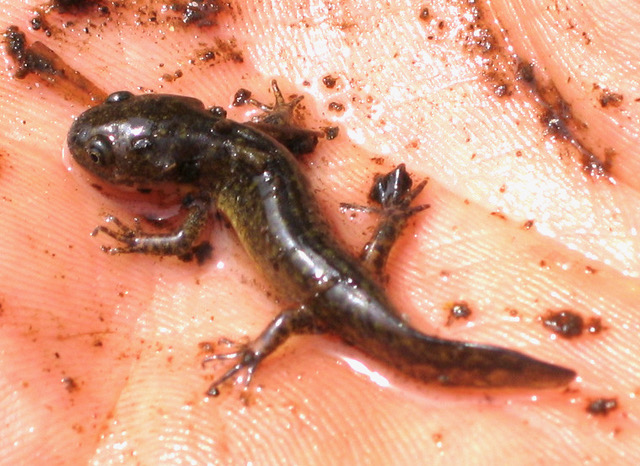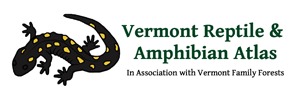
Herp Update: Night Activity, Habitats+Highways Award, Kickstarter continues — November 29, 2022
Recent Herp Activity
Last Sunday, November 27th, with the temperature at 41 F and a steady rain since mid-afternoon, I headed out around 9 PM to check to see what amphibians had been encouraged to move at our Morgan Road crossing site in Salisbury. I spent 15 minutes walking over and back through the crossing area.
In that time, I found 16 Eastern Red-backed Salamanders, three Spotted Salamanders, two Four-toed Salamanders, and one Wood Frog. Two of the Spotted Salamanders were this year’s young (see attached photo), but the rest of the amphibians were adults.
There was no clear migrational direction. Most seemed to be moving around for a late fall snack. Sadly, many of them had been run over. That is not usually the case at our Morgan Road crossing area, but in this case I think there has been increased traffic on that road due to deer hunters. It was the last evening of rifle deer season.
We have seen Red-backs moving around during January thaws in past years, but not the other species. I expect there will be amphibian activity again tomorrow (Wednesday) night, based on the current forecast. If you go out, make a mental note on which direction they seem to be heading.
Habitats and Highways Award
Together with the Vermont Agency of Transportation (VTrans), Vermont Fish and Wildlife, and Keeping Track, we have co-taught a course for VTrans employees and consultants called Habitats and Highways for the last twenty years. Fellow herper and VTrans employee Chris Slesar started the course.
The goal of the course is to teach VTrans employees and consultants how to minimize the impact of transportation infrastructure on wildlife and to facilitate communication between VTrans employees and wildlife biologists. The course deals with impacts on all species of wildlife, but due to their small size, slow speed, and need to move between multiple habitat types, reptiles and amphibians are the taxonomic groups that are most at risk of population losses due to roads.
These classes have helped Vermont become a leader in its efforts to minimize wildlife mortality on roads. This July, the Vermont Reptile and Amphibian Atlas, VTrans, VT Fish and Wildlife, and Keeping Track were presented with an Environmental Excellence Award from the Federal Highway Administration. This is not a monetary award, but it is really satisfying to be recognized on a national level for our contribution to this course.
Kickstarter continues for another two weeks
Thanks to you, the Kickstarter campaign for our Field Guide to Vermont Amphibians very quickly reached its original goal of $2,500. Teage O’ Conner of Crow’s Path extended the goal in that campaign to $5,000. Since there are a number of amphibian images that still need some editing, I think the additional dollars will be needed.
If you have any interest in pre-buying one of our guides or just making a contribution to this cooperative project, please visit:
https://www.kickstarter.com/projects/crowspath/field-guide-to-the-amphibians-of-vermont
As a reminder, Teage contacted us this spring asking for our collaboration in putting together a waterproof, tearproof, foldable, and super handy field guide to the amphibians of Vermont. Since then we have been working together to finalize the text, images, and maps.
Ecological Economics
Since habitat loss, habitat fragmentation, and habitat degradation are the primary causes of wildlife losses worldwide, and since all three are the results of human population growth and increasing resource use per person, we think it is important to periodically point out that both human population growth worldwide and resource use need to be stabilized. Sadly, some older economic models are based on the idea of perpetual growth of our human population and the amount of resources used per person. Newer models put forth by ecological economists (economists with training in ecology), recognize that perpetual growth is not sustainable and will result not only in wildlife population losses, but degradation of our own life support system. I wrote a commentary about the myth of perpetual growth that was published this week in Vermont Digger. If you are interested in reading the commentary, visit:
Jim Andrews: The myth of perpetual growth ignores that our planet is finite
Spotted Salamander (young)
Attached is a photo of a recently metamorphosed Spotted Salamander. This one had just left the pond where it went through its larval stage. The young Spotted Salamanders I saw Sunday night were two months older than this one and had developed their yellow spots.


